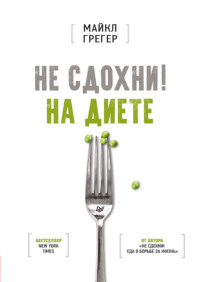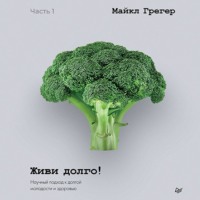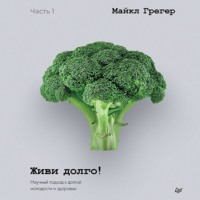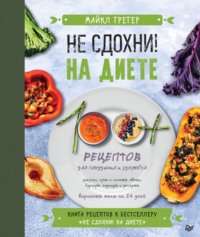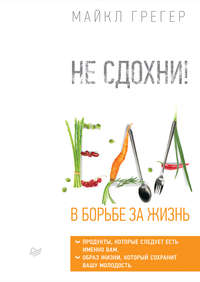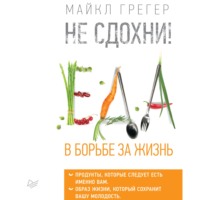
Полная версия
Живи долго! Научный подход к долгой молодости и здоровью
Ludwig IA, Mena P, Calani L, et al. Variations in caffeine and chlorogenic acid contents of coffees: what are we drinking? Food Funct. 2014;5(8):1718–26. https://pubmed.ncbi.nlm.nih.gov/25014672/
288
Mills CE, Oruna-Concha MJ, Mottram DS, Gibson GR, Spencer JPE. The effect of processing on chlorogenic acid content of commercially available coffee. Food Chem. 2013;141(4):3335–40. https://pubmed.ncbi.nlm.nih.gov/23993490/
289
Ludwig IA, Mena P, Calani L, et al. Variations in caffeine and chlorogenic acid contents of coffees: what are we drinking? Food Funct. 2014;5(8):1718–26. https://pubmed.ncbi.nlm.nih.gov/25014672/
290
Corrêa TAF, Monteiro MP, Mendes TMN, et al. Medium light and medium roast paper-filtered coffee increased antioxidant capacity in healthy volunteers: results of a randomized trial. Plant Foods Hum Nutr. 2012;67(3):277–82. https://pubmed.ncbi.nlm.nih.gov/22766993/
291
DiBaise JK. A randomized, double-blind comparison of two different coffee-roasting processes on development of heartburn and dyspepsia in coffee-sensitive individuals. Dig Dis Sci. 2003;48(4):652–6. https://pubmed.ncbi.nlm.nih.gov/12741451/
292
Liu J, Wang Q, Zhang H, Yu D, Jin S, Ren F. Interaction of chlorogenic acid with milk proteins analyzed by spectroscopic and modeling methods. Spectrosc Lett. 2016;49(1):44–50. https://www.tandfonline.com/doi/full/10.1080/00387010.2015.1066826
293
Duarte GS, Farah A. Effect of simultaneous consumption of milk and coffee on chlorogenic acids’ bioavailability in humans. J Agric Food Chem. 2011;59(14):7925–31. https://pubmed.ncbi.nlm.nih.gov/21627318/
294
Lorenz M, Jochmann N, von Krosigk A, et al. Addition of milk prevents vascular protective effects of tea. Eur Heart J. 2007;28(2):219–23. https://pubmed.ncbi.nlm.nih.gov/17213230/
295
Serafini M, Testa MF, Villaño D, et al. Antioxidant activity of blueberry fruit is impaired by association with milk. Free Radic Biol Med. 2009;46(6):769–74. https://pubmed.ncbi.nlm.nih.gov/19135520/
296
Serafini M, Bugianesi R, Maiani G, Valtuena S, De Santis S, Crozier A. Plasma antioxidants from chocolate. Nature. 2003;424(6952):1013. https://pubmed.ncbi.nlm.nih.gov/12944955/
297
Budryn G, Palecz B, Rachwal-Rosiak D, et al. Effect of inclusion of hydroxycinnamic and chlorogenic acids from green coffee bean in ß-cyclodextrin on their interactions with whey, egg white and soy protein isolates. Food Chem. 2015;168:276–87. https://pubmed.ncbi.nlm.nih.gov/25172711/
298
Felberg I, Farah A, Monteiro M, et al. Effect of simultaneous consumption of soymilk and coffee on the urinary excretion of isoflavones, chlorogenic acids and metabolites in healthy adults. J Funct Foods. 2015;19:688–99. https://www.sciencedirect.com/science/article/pii/S1756464615004910?via%3Dihub
299
Colombo R, Papetti A. An outlook on the role of decaffeinated coffee in neurodegenerative diseases. Crit Rev Food Sci Nutr. 2020;60(5):760–79. https://pubmed.ncbi.nlm.nih.gov/30614247/
300
Tverdal A, Selmer R, Cohen JM, Thelle DS. Coffee consumption and mortality from cardiovascular diseases and total mortality: does the brewing method matter? Eur J Prev Cardiol. 2020;27(18):1986–93. https://pubmed.ncbi.nlm.nih.gov/32320635/
301
Aubin HJ, Luquiens A, Berlin I. Letter by Aubin et al regarding article, “Association of coffee consumption with total and cause-specific mortality in 3 large prospective cohorts.” Circulation. 2016;133(20):e659. https://pubmed.ncbi.nlm.nih.gov/27185028/
302
Sakaki JR, Melough MM, Provatas AA, Perkins C, Chun OK. Evaluation of estrogenic chemicals in capsule and French press coffee using ultra-performance liquid chromatography with tandem mass spectrometry. Toxicol Rep. 2020;7:1020–4. https://pubmed.ncbi.nlm.nih.gov/32874926/
303
Yang CZ, Yaniger SI, Jordan VC, Klein DJ, Bittner GD. Most plastic products release estrogenic chemicals: a potential health problem that can be solved. Environ Health Perspect. 2011;119(7):989–96. https://pubmed.ncbi.nlm.nih.gov/21367689/
304
Sakaki JR, Melough MM, Provatas AA, Perkins C, Chun OK. Evaluation of estrogenic chemicals in capsule and French press coffee using ultra-performance liquid chromatography with tandem mass spectrometry. Toxicol Rep. 2020;7:1020–4. https://pubmed.ncbi.nlm.nih.gov/32874926/
305
Li M, Wang M, Guo W, Wang J, Sun X. The effect of caffeine on intraocular pressure: a systematic review and meta-analysis. Graefes Arch Clin Exp Ophthalmol. 2011;249(3):435–42. https://pubmed.ncbi.nlm.nih.gov/20706731/
306
Kang JH, Willett WC, Rosner BA, Hankinson SE, Pasquale LR. Caffeine consumption and the risk of primary open-angle glaucoma: a prospective cohort study. Invest Ophthalmol Vis Sci. 2008;49(5):1924–31. https://pubmed.ncbi.nlm.nih.gov/18263806/
307
Gleason JL, Richter HE, Redden DT, Goode PS, Burgio KL, Markland AD. Caffeine and urinary incontinence in US women. Int Urogynecol J. 2013;24(2):295–302. https://pubmed.ncbi.nlm.nih.gov/22699886/
308
Davis NJ, Vaughan CP, Johnson TM, et al. Caffeine intake and its association with urinary incontinence in United States men: results from National Health and Nutrition Examination Surveys 2005–2006 and 2007–2008. J Urol. 2013;189(6):2170–4. https://pubmed.ncbi.nlm.nih.gov/23276513/
309
Bonilha L, Li LM. Heavy coffee drinking and epilepsy. Seizure. 2004;13(4):284–5. https://pubmed.ncbi.nlm.nih.gov/15121141/
310
Surdea-Blaga T, Negrutiu DE, Palage M, Dumitrascu DL. Food and gastroesophageal reflux disease. Curr Med Chem. 2019;26(19):3497–511. https://pubmed.ncbi.nlm.nih.gov/28521699/
311
Lloret-Linares C, Lafuente-Lafuente C, Chassany O, et al. Does a single cup of coffee at dinner alter the sleep? A controlled cross-over randomised trial in real-life conditions. Nutr Diet. 2012;69(4):250–5. https://onlinelibrary.wiley.com/doi/10.1111/j.1747–0080.2012.01601.x
312
Poole R, Kennedy OJ, Roderick P, Fallowfield JA, Hayes PC, Parkes J. Coffee consumption and health: umbrella review of meta-analyses of multiple health outcomes. BMJ. 2017;359:j5024. https://pubmed.ncbi.nlm.nih.gov/29167102/
313
Son H, Song HJ, Seo HJ, Lee H, Choi SM, Lee S. The safety and effectiveness of self-administered coffee enema: a systematic review of case reports. Medicine. 2020;99(36):e21998. https://pubmed.ncbi.nlm.nih.gov/32899046/
314
Dirks-Naylor AJ. The benefits of coffee on skeletal muscle. Life Sci. 2015;143:182–6. https://pubmed.ncbi.nlm.nih.gov/26546720/
315
Juliano LM, Griffiths RR. A critical review of caffeine withdrawal: empirical validation of symptoms and signs, incidence, severity, and associated features. Psychopharmacology (Berl). 2004;176(1):1–29. https://pubmed.ncbi.nlm.nih.gov/15448977/
316
O’Keefe JH, Bhatti SK, Patil HR, DiNicolantonio JJ, Lucan SC, Lavie CJ. Effects of habitual coffee consumption on cardiometabolic disease, cardiovascular health, and all-cause mortality. J Am Coll Cardiol. 2013;62(12):1043–51. https://pubmed.ncbi.nlm.nih.gov/23871889/
317
Mendez JD. The other legacy of Antonie van Leeuwenhoek: the polyamines. J Clin Mol Endocrinol. 2017;02(01):e107. https://clinical-and-molecular-endocrinology.imedpub.com/the-other-legacy-of-antonie-van-leeuwenhoek-the-polyamines.php?aid=19400
318
Bachrach U. The early history of polyamine research. Plant Physiol Biochem. 2010;48(7):490–5. https://pubmed.ncbi.nlm.nih.gov/20219382/
319
Guerra GP, Rubin MA, Mello CF. Modulation of learning and memory by natural polyamines. Pharmacol Res. 2016;112:99–118. https://pubmed.ncbi.nlm.nih.gov/27015893/
320
Madeo F, Bauer MA, Carmona-Gutierrez D, Kroemer G. Spermidine: a physiological autophagy inducer acting as an anti-aging vitamin in humans? Autophagy. 2019;15(1):165–8. https://pubmed.ncbi.nlm.nih.gov/30306826/
321
Madeo F, Eisenberg T, Pietrocola F, Kroemer G. Spermidine in health and disease. Science. 2018;359(6374):eaan2788. https://pubmed.ncbi.nlm.nih.gov/29371440/
322
Hunter DC, Burritt DJ. Polyamines of plant origin: an important dietary consideration for human health. In: Rao V, ed. Phytochemicals as Nutraceuticals: Global Approaches to Their Role in Nutrition and Health. InTech; 2012:225–44. https://www.intechopen.com/chapters/32904
323
Kaeberlein M. Spermidine surprise for a long life. Nat Cell Biol. 2009;11(11):1277–8. https://pubmed.ncbi.nlm.nih.gov/19884883/
324
Hunter DC, Burritt DJ. Polyamines of plant origin: an important dietary consideration for human health. In: Rao V, ed. Phytochemicals as Nutraceuticals: Global Approaches to Their Role in Nutrition and Health. InTech; 2012:225–44. https://www.intechopen.com/chapters/32904
325
Minois N, Carmona-Gutierrez D, Madeo F. Polyamines in aging and disease. Aging (Albany NY). 2011;3(8):716–32. https://pubmed.ncbi.nlm.nih.gov/21869457/
326
Soda K, Dobashi Y, Kano Y, Tsujinaka S, Konishi F. Polyamine-rich food decreases age-associated pathology and mortality in aged mice. Exp Gerontol. 2009;44(11):727–32. https://pubmed.ncbi.nlm.nih.gov/19735716/
327
Yue F, Li W, Zou J, et al. Spermidine prolongs lifespan and prevents liver fibrosis and hepatocellular carcinoma by activating map1s-mediated autophagy. Cancer Res. 2017;77(11):2938–51. https://pubmed.ncbi.nlm.nih.gov/28386016/
328
Eisenberg T, Knauer H, Schauer A, et al. Induction of autophagy by spermidine promotes longevity. Nat Cell Biol. 2009;11(11):1305–14. https://pubmed.ncbi.nlm.nih.gov/19801973/
329
Rudman D, Kutner MH, Chawla RK, Goldsmith MA, Blackston RD, Bain R. Serum and urine polyamines in normal and in short children. J Clin Invest. 1979;64(6):1661–8. https://pubmed.ncbi.nlm.nih.gov/500832/
330
Pucciarelli S, Moreschini B, Micozzi D, et al. Spermidine and spermine are enriched in whole blood of nona/centenarians. Rejuvenation Res. 2012;15(6):590–5. https://pubmed.ncbi.nlm.nih.gov/22950434/
331
Piore A. Can blood from young people slow aging? Silicon Valley bets it will. Newsweek. April 7, 2021. https://www.newsweek.com/2021/04/16/can-blood-young-people-slow-aging-silicon-valley-has-bet-billions-it-will-1581447.html. Accessed December 25, 2022.; https://www.newsweek.com/2021/04/16/can-blood-young-people-slow-aging-silicon-valley-has-bet-billions-it-will-1581447.html
332
Viltard M, Durand S, Pérez-Lanzón M, et al. The metabolomic signature of extreme longevity: naked mole rats versus mice. Aging (Albany NY). 2019;11(14):4783–800. https://pubmed.ncbi.nlm.nih.gov/31346149/
333
Pucciarelli S, Moreschini B, Micozzi D, et al. Spermidine and spermine are enriched in whole blood of nona/centenarians. Rejuvenation Res. 2012;15(6):590–5. https://pubmed.ncbi.nlm.nih.gov/22950434/
334
Eisenberg T, Abdellatif M, Schroeder S, et al. Cardioprotection and lifespan extension by the natural polyamine spermidine. Nat Med. 2016;22(12):1428–38. https://pubmed.ncbi.nlm.nih.gov/27841876/
335
Flurkey K, Currer JM, Harrison DE. 2007. The Mouse in Aging Research. In The Mouse in Biomedical Research 2nd Edition. Fox JG, et al, editors. American College Laboratory Animal Medicine (Elsevier), Burlington, MA. pp. 637–72.; https://www.sciencedirect.com/science/article/abs/pii/B9780123694546500741?via%3Dihub
336
Eisenberg T, Abdellatif M, Schroeder S, et al. Cardioprotection and lifespan extension by the natural polyamine spermidine. Nat Med. 2016;22(12):1428–38. https://pubmed.ncbi.nlm.nih.gov/27841876/
337
Filfan M, Olaru A, Udristoiu I, et al. Long-term treatment with spermidine increases health span of middle-aged Sprague-Dawley male rats. GeroScience. 2020;42(3):937–49. https://pubmed.ncbi.nlm.nih.gov/32285289/
338
Pekar T, Bruckner K, Pauschenwein-Frantsich S, et al. The positive effect of spermidine in older adults suffering from dementia: first results of a 3-month trial. Wien Klin Wochenschr. 2021;133:484–91. https://pubmed.ncbi.nlm.nih.gov/33211152/
339
Handa AK, Fatima T, Mattoo AK. Polyamines: bio-molecules with diverse functions in plant and human health and disease. Front Chem. 2018;6. https://pubmed.ncbi.nlm.nih.gov/29468148/
340
Rinaldi F, Marzani B, Pinto D, Ramot Y. A spermidine-based nutritional supplement prolongs the anagen phase of hair follicles in humans: a randomized, placebo-controlled, double-blind study. Derm Pract Concept. Published online October 31, 2017:17–21.; https://pubmed.ncbi.nlm.nih.gov/29214104/
341
Metur SP, Klionsky DJ. The curious case of polyamines: spermidine drives reversal of B cell senescence. Autophagy. 2020;16(3):389–90. https://pubmed.ncbi.nlm.nih.gov/31795807/
342
Zhang H, Alsaleh G, Feltham J, et al. Polyamines control eIF5A hypusination, TFEB translation, and autophagy to reverse B cell senescence. Mol Cell. 2019;76(1):110–25.e9. https://pubmed.ncbi.nlm.nih.gov/31474573/
343
Metur SP, Klionsky DJ. The curious case of polyamines: spermidine drives reversal of B cell senescence. Autophagy. 2020;16(3):389–90. https://pubmed.ncbi.nlm.nih.gov/31795807/
344
de Cabo R, Navas P. Spermidine to the rescue for an aging heart. Nat Med. 2016;22(12):1389–90. https://pubmed.ncbi.nlm.nih.gov/27923032/
345
Eisenberg T, Abdellatif M, Schroeder S, et al. Cardioprotection and lifespan extension by the natural polyamine spermidine. Nat Med. 2016;22(12):1428–38. https://pubmed.ncbi.nlm.nih.gov/27841876/
346
Fetterman JL, Holbrook M, Flint N, et al. Restoration of autophagy in endothelial cells from patients with diabetes mellitus improves nitric oxide signaling. Atherosclerosis. 2016;247:207–17. https://pubmed.ncbi.nlm.nih.gov/26926601/
347
Eisenberg T, Abdellatif M, Schroeder S, et al. Cardioprotection and lifespan extension by the natural polyamine spermidine. Nat Med. 2016;22(12):1428–38. https://pubmed.ncbi.nlm.nih.gov/27841876/
348
Kiechl S, Pechlaner R, Willeit P, et al. Higher spermidine intake is linked to lower mortality: a prospective population-based study. Am J Clin Nutr. 2018;108(2):371–80. https://pubmed.ncbi.nlm.nih.gov/29955838/
349
Kiechl S, Pechlaner R, Willeit P, et al. Higher spermidine intake is linked to lower mortality: a prospective population-based study. Am J Clin Nutr. 2018;108(2):371–80. https://pubmed.ncbi.nlm.nih.gov/29955838/
350
Kiechl S, Pechlaner R, Willeit P, et al. Higher spermidine intake is linked to lower mortality: a prospective population-based study. Am J Clin Nutr. 2018;108(2):371–80. https://pubmed.ncbi.nlm.nih.gov/29955838/
351
Madeo F, Bauer MA, Carmona-Gutierrez D, Kroemer G. Spermidine: a physiological autophagy inducer acting as an anti-aging vitamin in humans? Autophagy. 2019;15(1):165–8. https://pubmed.ncbi.nlm.nih.gov/30306826/
352
Pekar T, Bruckner K, Pauschenwein-Frantsich S, et al. The positive effect of spermidine in older adults suffering from dementia: first results of a 3-month trial. Wien Klin Wochenschr. 2021;133:484–91. https://pubmed.ncbi.nlm.nih.gov/33211152/
353
Madeo F, Eisenberg T, Pietrocola F, Kroemer G. Spermidine in health and disease. Science. 2018;359(6374):eaan2788. https://pubmed.ncbi.nlm.nih.gov/29371440/
354
Madeo F, Hofer SJ, Pendl T, et al. Nutritional aspects of spermidine. Annu Rev Nutr. 2020;40(1):135–59. https://pubmed.ncbi.nlm.nih.gov/32634331/
355
Zoumas-Morse C, Rock CL, Quintana EL, Neuhouser ML, Gerner EW, Meyskens FL. Development of a polyamine database for assessing dietary intake. J Am Diet Assoc. 2007;107(6):1024–7. https://pubmed.ncbi.nlm.nih.gov/17524725/
356
Kalac P. Health effects and occurrence of dietary polyamines: a review for the period 2005–mid 2013. Food Chem. 2014;161:27–39. https://pubmed.ncbi.nlm.nih.gov/24837918/
357
Еще раз напомним, что американская единица объема «чашка» (cup) равна 240 мл: здесь и далее во всех рецептах. – Примеч. ред.
358
Ali MA, Poortvliet E, Strömberg R, Yngve A. Polyamines: total daily intake in adolescents compared to the intake estimated from the Swedish Nutrition Recommendations Objectified (Sno). Food Nutr Res. 2011;55(1):5455. https://pubmed.ncbi.nlm.nih.gov/21249160/
359
Varghese N, Werner S, Grimm A, Eckert A. Dietary mitophagy enhancer: a strategy for healthy brain aging? Antioxidants (Basel). 2020;9(10). https://pubmed.ncbi.nlm.nih.gov/33003315/
360
Handa AK, Fatima T, Mattoo AK. Polyamines: bio-molecules with diverse functions in plant and human health and disease. Front Chem. 2018;6. https://pubmed.ncbi.nlm.nih.gov/29468148/
361
Agricultural Research Service, United States Department of Agriculture. Dill weed, fresh. FoodData Central. https://fdc.nal.usda.gov/fdc-app.html?query=dill&utf8=%E2%9C%93&affiliate=usda&commit=Search#/food-details/172233/nutrients. Published April 1, 2019. Accessed April 30, 2021.; https://fdc.nal.usda.gov/fdc-app.html?query=dill&utf8=%E2%9C%93&affiliate=usda&commit=Search#/food-details/172233/nutrients
362
Kalac P. Health effects and occurrence of dietary polyamines: a review for the period 2005–mid 2013. Food Chem. 2014;161:27–39. https://pubmed.ncbi.nlm.nih.gov/24837918/
363
Agricultural Research Service, United States Department of Agriculture. Potato, baked, NFS. FoodData Central. https://fdc.nal.usda.gov/fdc-app.html?query=potato&utf8=%E2%9C%93&affiliate=usda&commit=Search#/food-details/1102880/nutrients. Published October 30, 2020. Accessed April 30, 2021.; https://fdc.nal.usda.gov/fdc-app.html?query=potato&utf8=%E2%9C%93&affiliate=usda&commit=Search#/food-details/1102880/nutrients
364
Atiya Ali M, Poortvliet E, Strömberg R, Yngve A. Polyamines in foods: development of a food database. Food Nut Res. 2011;55(1):5572. https://pubmed.ncbi.nlm.nih.gov/21249159/
365
Agricultural Research Service, United States Department of Agriculture. Garlic, raw. FoodData Central. https://fdc.nal.usda.gov/fdc-app.html?query=garlic&utf8=%E2%9C%93&affiliate=usda&commit=Search#/food-details/1103354/nutrients. Published October 30, 2020. Accessed April 30, 2021.; https://fdc.nal.usda.gov/fdc-app.html?query=apples&utf8=%E2%9C%93&affiliate=usda&commit=Search#/food-details/1102644/nutrients
366
Nishimura K, Shiina R, Kashiwagi K, Igarashi K. Decrease in polyamines with aging and their ingestion from food and drink. J Biochem. 2006;139(1):81–90. https://pubmed.ncbi.nlm.nih.gov/16428322/
367
Okamoto A, Sugi E, Koizumi Y, Yanagida F, Udaka S. Polyamine content of ordinary foodstuffs and various fermented foods. Biosci Biotechnol Biochem. 1997;61(9):1582–4. https://pubmed.ncbi.nlm.nih.gov/9339564/
368
Kiechl S, Pechlaner R, Willeit P, et al. Higher spermidine intake is linked to lower mortality: a prospective population-based study. Am J Clin Nutr. 2018;108(2):371–80. https://pubmed.ncbi.nlm.nih.gov/29955838/
369
Atiya Ali M, Poortvliet E, Strömberg R, Yngve A. Polyamines in foods: development of a food database. Food Nutr Res. 2011;55(1):5572. https://pubmed.ncbi.nlm.nih.gov/21249159/
370
Kalac P. Health effects and occurrence of dietary polyamines: a review for the period 2005–mid 2013. Food Chem. 2014;161:27–39. https://pubmed.ncbi.nlm.nih.gov/24837918/
371
Kalac P. Health effects and occurrence of dietary polyamines: a review for the period 2005–mid 2013. Food Chem. 2014;161:27–39. https://pubmed.ncbi.nlm.nih.gov/24837918/
372
Kiechl S, Pechlaner R, Willeit P, et al. Higher spermidine intake is linked to lower mortality: a prospective population-based study. Am J Clin Nutr. 2018;108(2):371–80. https://pubmed.ncbi.nlm.nih.gov/29955838/
373
Atiya Ali M, Poortvliet E, Strömberg R, Yngve A. Polyamines in foods: development of a food database. Food Nutr Res. 2011;55(1):5572. https://pubmed.ncbi.nlm.nih.gov/21249159/
374
Nishibori N, Fujihara S, Akatuki T. Amounts of polyamines in foods in Japan and intake by Japanese. Food Chem. 2007;100(2):491–7. https://www.sciencedirect.com/science/article/abs/pii/S0308814605008915?via%3Dihub
375
Nishimura K, Shiina R, Kashiwagi K, Igarashi K. Decrease in polyamines with aging and their ingestion from food and drink. J Biochem. 2006;139(1):81–90. https://pubmed.ncbi.nlm.nih.gov/16428322/
376
Atiya Ali M, Poortvliet E, Strömberg R, Yngve A. Polyamines in foods: development of a food database. Food Nutr Res. 2011;55(1):5572. https://pubmed.ncbi.nlm.nih.gov/21249159/
377
Cipolla BG, Havouis R, Moulinoux JP. Polyamine contents in current foods: a basis for polyamine reduced diet and a study of its long term observance and tolerance in prostate carcinoma patients. Amino Acids. 2007;33(2):203–12. https://pubmed.ncbi.nlm.nih.gov/17578651/
378
Atiya Ali M, Poortvliet E, Strömberg R, Yngve A. Polyamines in foods: development of a food database. Food Nutr Res. 2011;55(1):5572. https://pubmed.ncbi.nlm.nih.gov/21249159/
379
Atiya Ali M, Poortvliet E, Strömberg R, Yngve A. Polyamines in foods: development of a food database. Food Nutr Res. 2011;55(1):5572. https://pubmed.ncbi.nlm.nih.gov/21249159/
380
Atiya Ali M, Poortvliet E, Strömberg R, Yngve A. Polyamines in foods: development of a food database. Food Nutr Res. 2011;55(1):5572. https://pubmed.ncbi.nlm.nih.gov/21249159/
381
Nishibori N, Fujihara S, Akatuki T. Amounts of polyamines in foods in Japan and intake by Japanese. Food Chem. 2007;100(2):491–7. https://www.sciencedirect.com/science/article/abs/pii/S0308814605008915?via%3Dihub
382
Kiechl S, Pechlaner R, Willeit P, et al. Higher spermidine intake is linked to lower mortality: a prospective population-based study. Am J Clin Nutr. 2018;108(2):371–80. https://pubmed.ncbi.nlm.nih.gov/29955838/
383
Atiya Ali M, Poortvliet E, Strömberg R, Yngve A. Polyamines in foods: development of a food database. Food Nutr Res. 2011;55(1):5572. https://pubmed.ncbi.nlm.nih.gov/21249159/







